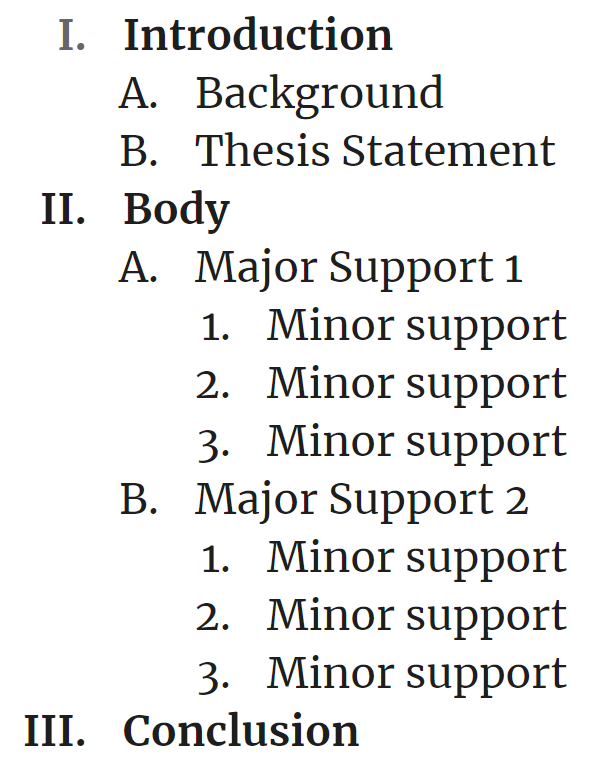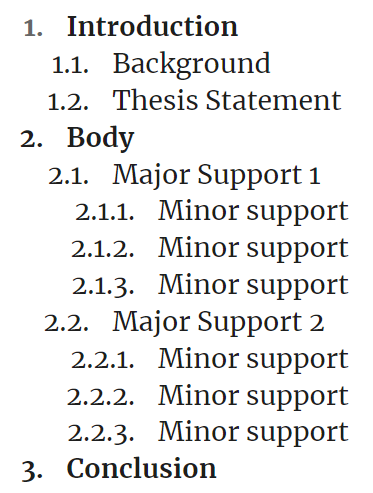EAPP Midterms Reviewer
1/53
Name | Mastery | Learn | Test | Matching | Spaced |
|---|
No study sessions yet.
54 Terms
Academic
Literary
Transactional
Informative
LITA
The 4 main types of texts
Academic text
Type of text
Defined as critical, objective, specialized texts
Written by experts/professionals
Uses formal (and technical) language
Essay
Research
Reaction paper
Journal
Book review
Synthesis
Review of the literature
RRRJEBS
Types of academic text (7 items)
Observes structure
Applies appropriate tone
Uses clear language
Cites sources of information
Addresses complex issues
Provides evidence-based arguments
Thesis-driven
CAAPOUT
Nature & characteristics of academic texts (7 items)
Complex
Formal
Precise
Objective
Explicit
Accurate
Cautious (hedging)
Responsible
Organized
Well-planned
POOR-FAE-WCC
Features of academic texts (10 items)
Locate main idea
Scan information
Identify gaps in existing studies
Connect new ideas to existing ones
Gain more information
Support a writing assignment
Understand an existing idea
SSIC-LUG
Purposes of reading academic texts (7 items)
Purpose
Audience
Perspective
Language
PALP or PPAL or LAPP
4 factors to consider in writing academic texts
States critical issues
Provides facts and evidence
Uses precise and accurate words
Objective POV
References
Cautious language
SOUP-RC
Language of academic texts
Formal
Characteristic of academic language
It should not sound conversational or casual
Avoid colloquial, idiomatic, slang or journalistic expressions
Impartial
Characteristic of academic language
Involves avoiding the personal pronouns ‘I’ and ‘we’
Objective
Characteristic of academic language
Unbiased
Based on facts and evidence and are not influenced by personal feelings
Reporting verbs
Lexical verbs
Modals
That clauses
Adverbs of frequency
MART-L
Types of hedging language
Outline
Organized list of
steps
ideas
information
Arranged hierarchically under headings and subheadings
Visual strategy
Helpful in organizing, clarifying, and structuring information and ideas
Research, organize and compile information in an orderly manner
Compare, prioritize and decide on topics and ideas to be included
Derive a general structure to work with
RCD
Outlining helps …
Filter unnecessary information
Organize information
Get an overview of the task at hand for better planning
FOG
By writing outlines, you can …
Format
Topic outline
Sentence outline
Style
Alphanumeric
Decimal
Types of outlines
Topic outline
Uses keywords and phrases
Rely heavily on parallelism
Sentence outline
It expresses each point as a complete sentence
Alphanumeric
The traditional outline format

Decimal
The standard outline format

Parallelism
Coordination
Subordination
Division
PC-SD
The 4 principles of outlining
Parallelism
Principle of outlining
All items in formal outlines must be parallel in grammar and structure
If 1 starts with a verb, the others must as well
However, reasonableness and flexibility of form is preferred to rigidity
Coordination
Principle of outlining
Each point should have the same relationship to your main point
Subordination
Principle of outlining
Each point in the outline goes from general headings to more specific subpoints
Division
Principle of outlining
Each main point (or heading) on your outline must have at least two subpoints
Reduce cognitive load
Organizing & chunking
Visual representation
Prioritizing information
Active learning
Transfer knowledge
PAVORT
What is the connection between outlining and information processing? (6 items)
Summary
A condensed version of a longer text
Includes the main idea, major supporting points, and should reveal the relationship between them
To increase comprehension and retention of information
To keep track of your observations
To make convincing analyses of sources
To record what you’ve read and help distinguish your ideas from those of your sources
ACOD
Why should you summarize? (4 items)
Read the original text
Underline the main idea
Extract major details
State the main idea in your own words
Introduce the source of information
RUE SI
5 steps of summarizing
Informative
Descriptive
2 types of summaries
Informative summary
Type of summary
Adopts the tone of the original text, simply presenting the information it contains in shorter form
Descriptive summary
Type of summary
Adopts a more distant perspective, describing the original text rather than directly presenting the information it contains
Academic writing
Citations
Reporting verbs
(1) requires you to use (2) to refer to the original source when you have used someone else’s ideas or concepts in your writing. One of the most common ways to incorporate these (2) into your writing is to use (3) to present the information.
Balanced
Objective
Brief
Original
BOBO
4 principles of an effective summary
Thesis statement
The main idea of a composition
Provides the controlling idea
Specifc topic + specific claim
Is an answer to a research question
Predicts, controls and obligates
Is an indicator of position/belief about a particular idea
Different from the topic sentence
DAPI
A good thesis statement … (4 items)
It should provide a clear line of focus
It must set limits on a topic
It isn’t the topic/title/question
Pitfalls in writing thesis statements (3 items)
Too specific
Expresses more than 1 idea
Vague
VET
Bad theses are … (3 items)
Fact/Definition
Cause
Value
Policy
4 types of claims
Claim of fact/definition
Type of claim
Argues about what the definition of something is or whether something is a fact
Support:
Formal and extended definition
Quotes from authorities
Comparison and contrast
Claim of cause
Type of claim
Argues that something/someone caused another thing
Support:
Facts or statistics
Induction or deduction
Cause-effect organization
Claim of value
Type of claim
Made of what something is worth
Whether we value it or not
How we would rate or categorize something
Support:
Appeal to audience’s values
Quotes from authorities
Claim-reason-evidence pattern
Claim of policy
Type of claim
Argues for or against a certain solution or policy approach to a problem
Support:
Facts or statistics
Problem-solution pattern
Explicit
When the thesis outlines the main idea and the organization of the essay for the reader
Implicit
When the thesis introduces the topic, but doesn’t outline the supporting ideas
Clear
Contestable
Concentrated
Complex
Compelling
Connected
6 Cs of theses
Ask a question
Create a declaration
List three reasons why
Combine #2 and #3 and write the thesis
AC-LC
4 steps of writing a thesis
Concept paper
It aims to clarify a concept which can be about any topic from any field
Short summary that tells the reader what a project is, why it’s important and how it’ll be carried out
It aims to capture the thoughts and ideas (Lango, 2019)
Length
Format and design
2 features of a concept paper
500 to 2K words
Usual length of a concept paper
Per the funding agency of
Usual format and design of a concept paper
Project
Research
2 types of concept papers
Cover page
Introduction
Rationale or background
Project description
Project needs and cost
5 parts of a project proposal/concept paper
Title page
Background of the study
Preliminary literature review
Statement of the problem or objectives
(Abridged) methodology
Timeline
References
7 parts of a research proposal/concept paper